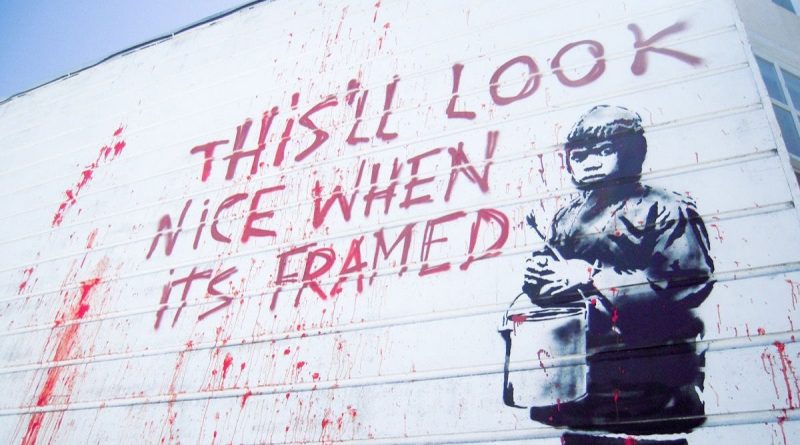Every year, Tribeca has at least one documentary covering street art. Shadowman and the more recent Martha: A Picture Story both covered aspects of graffiti and street artists from the 1970s onward, charting the changes specifically in the New York City landscape and the rise of young artists constantly at odds with the art establishment. One of the issues behind street art is the tension between the medium itself – walls, subway cars, store fronts, public and private buildings – and the rising fame of certain artists. Artists do have to make a living, yet street art is ephemeral and public, consumed by non-paying customers and destroyed or removed by authorities. The artist is anonymous by necessity, at least for a while, and you can’t really sell a wall, a subway car, or a park bench. Among the most famous artists to navigate this thorny issue (not always in a way that the public or private collectors like) is Banksy, the anonymous street artist who has been tagging public buildings and making political statements since sometime in the 90s. He’s the topic of the most recent documentary Banksy Most Wanted, directed by Aurelia Rouvier and Seamus Haley, which covers some of the artist’s most notorious works and the efforts by journalists and art dealers to discover his true identity.
Banksy Most Wanted focuses primarily on the mystique of Banksy – the way in which he seems to just be able to tag a wall, often with incredibly complex stencils, and then vanish, avoiding being captured on camera or caught by passersby. His former agent details some of the techniques artists use to avoid being caught, and fellow artists explain the changing mythology that has popped up around him. Art dealers, meanwhile, try to profit from his work, as they remove sections of buildings or strip stencils from walls to then be auctioned off to wealthy collectors. Given that much of Banksy’s work is referential to its surroundings, the film makes a clear political statement about the art world, but also highlights the tension – Banksy is one of the most famous artists in the world, his work is worth millions, and yet it is ultimately public work that’s intended to remain in its location and, eventually, vanish under the effects of time.

The second strand of the documentary focuses on a set of journalists determined to discover Banksy’s “true” identity. One traces the locations of his work in relation to Massive Attack tour dates; another claims to follow tax returns and company registrations after the release of Exit Through the Gift Shop, the documentary that Banksy produced. A third relies on tracking locations of images purported to be Banksy, and anonymous tips. And all come up with a different answer to Banksy’s identity.
Of course, the question is why it’s so important to know the identity of an artist who wants to remain anonymous. For the journalists, it’s primarily about notoriety, being able to say that they were the one who exposed Banksy. But many fans don’t want to know – knowing would ruin the mystique, possibly even dilute the importance of the work. There’s also the open question of how to prove it – Banksy has managed to avoid exposure so far, surrounding himself with entourage who refuse to divulge his identity and are constantly misleading people, so really the only way to prove his identity would be to catch him in the act of painting. (To be honest, the most realistic claim is that Banksy is multiple people, a team of artists who have hidden behind a single identity to avoid detection.)
Banksy Most Wanted is an interesting documentary, even if it doesn’t reveal much more than we already know about the artist and the importance of his work. It does evade some of the deeper criticisms of Banksy’s work – that it is becoming more about his personal fame than the political and artistic message. How Banksy supports himself, how he maintains anonymity, and why he produces the art he does becomes more of a question, one which the documentary doesn’t really attempt to answer. Most of the film, in fact, tones down criticism of the work, and there are very few talking heads here who raise issues about the content of the art.
Banksy Most Wanted provides an intriguing if limited glimpse into the world of street art and the continued fascination we have with an artist who will probably always be anonymous. But is that anonymity, begun because street artists don’t want to get arrested, now merely a PR ploy? Is it the courageous act of a Robin Hood who doesn’t want his good works revealed? Or is it really more about focusing on the art and its message, to avoid relating it to the artist’s individual or personal beliefs? If Banksy isn’t anyone, if we never know who he (or she, or they) is, then all we’re left with is the art. And the art, really, is what’s wanted.
Banksy Most Wanted is showing at the Tribeca Film Festival.

